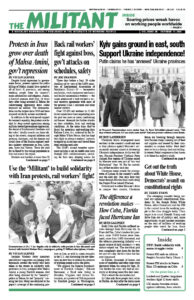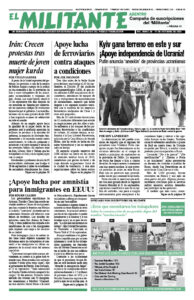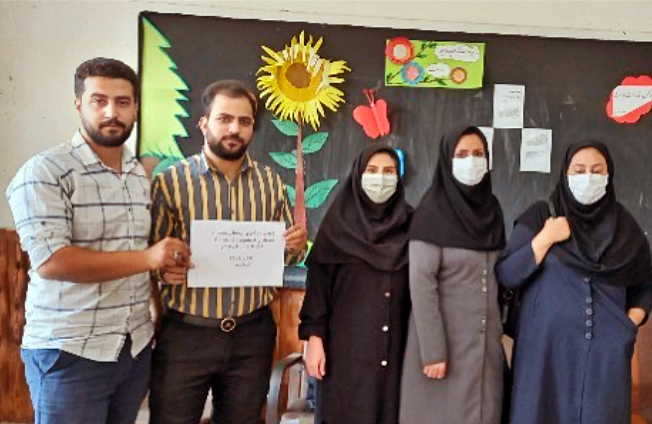Despite brutal repression by government forces, protests against the police killing of Mahsa Amini have spread to all of Iran’s 31 provinces, and among working people from the country’s main nationalities and religions. Amini, a Kurdish woman, died Sept. 16, three days after being arrested in Tehran for contravening oppressive dress codes imposed on women. The demonstrations are the largest since 2019 and have inspired solidarity actions worldwide.
In addition to the widespread support for women’s equality, the protests are fueled by deep-seated opposition among millions toward government oppression, the denial of fundamental freedoms and the rulers’ deadly assaults on those taking to the streets; rampant inflation and growing shortages; and the human and social costs of the Iranian regime’s endless military adventures in Iraq, Lebanon, Syria and Yemen. These are paid for in blood by the toiling population in Iran and across the region.
Students and teachers at more than 20 universities staged a strike Sept. 28. And thousands of high school students have walked out. At a high school in Shahriar, outside Tehran, students chanted, “No hijab, no hijab, freedom and equality.”
“I am here to accompany and support my daughter,” Abdolali, a teacher in Tehran who didn’t want to give his last name, told The Associated Press. He said he’d participated in the 1979 Iranian Revolution that had “promised justice and freedom; it is time to materialize them.”
On Oct. 2 the regime’s thugs surrounded Sharif University of Technology in Tehran, preventing student protesters from leaving and then fired tear gas at them. Hundreds were arrested. Days later demonstrators at dozens of other universities marched to demand the release of the jailed students.
At first the regime was cautious, even contacting Amini’s family to promise an investigation. But as protests spread the response of the government has been brutal, particularly against Kurds both in Iran and Iraq. News reports say 83 deaths have occurred, as government forces have opened up with live fire. On Sept. 30 at least 42 were killed in clashes in the Iranian city of Zahedan.
Thousands have been arrested, including Niloufar Hamedi, who reported on Amini’s death and funeral. Her husband said cops ransacked their home, confiscating laptops and mobile phones. She is being held in solitary confinement without being told what the charges are.
Supreme Leader Ayatollah Ali Khamenei tried to shift the focus, casting blame on agents of the Israeli and the U.S. governments Oct. 3 for allegedly inciting protests.
Tehran bombs Iraqi Kurds
The Iranian government unleashed a wave of missile and drone strikes beginning Sept. 28 on areas where three Iranian Kurdish opposition groups in exile in Iraqi Kurdistan are based. Brig.-Gen. Mohammad Pakpour, the top commander of the Islamic Revolutionary Guard Corps, bragged that Tehran had “completely demolished” the villages with 73 ballistic missiles and drones. At least 14 people were killed. Many farmers and nomads had to flee the area.
One Iranian drone directed toward Erbil, the capital of Iraqi Kurdistan, was shot down by U.S. forces. Nineteen years since the 2003 invasion of Iraq, the U.S. rulers still deploy some 2,500 troops there.
Iranian officials claim the popular protests sweeping Iran are stirred up by Kurds. An estimated 10 million Kurds, around a tenth of Iran’s population, have long been denied political and cultural rights. The solidarity shown by non-Kurdish Iranians with the country’s Kurds following Amini’s death is intolerable to them. At least 1,500 Kurds have been arrested in the last few weeks.
The Kurds are the largest oppressed people without a homeland worldwide — with some 30 million spread across Iraq, Iran, Syria and Turkey.
Workers and farmers in Iran bear the brunt of the worldwide capitalist economic crisis, compounded by U.S.-led sanctions that make it harder for Iranian companies to sell oil and get access to the global financial system. The Biden administration issued a fresh round of sanctions on Iran Sept. 29. They fall hardest on working people.
Today’s protests come on top of countrywide demonstrations that broke out in May when the government cut subsidies on essential food items. Iranians now pay about 75% more for food than they did a year ago. The official inflation rate in August was 52%. Nader, a construction company employee in Tehran, told the press, “I can’t keep up with the rising prices, no matter how hard I run.” With his savings gone and his rent doubled even cheese and eggs are becoming luxuries, he said.
“We support the people’s struggles against organized and everyday violence against women and against the poverty and hell that dominates the society,” the Organizing Council of Oil Contract Workers said on Sept. 26.
The Coordinating Council of Iranian Teachers Trade Union Associations called on teachers across the country to join the protests and appealed to soldiers to “put down your guns” and join the people.


